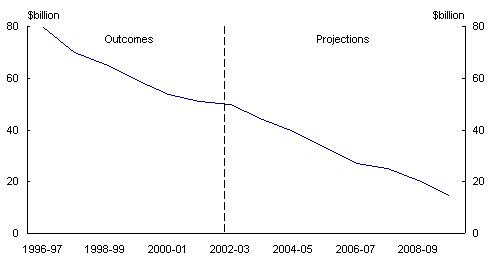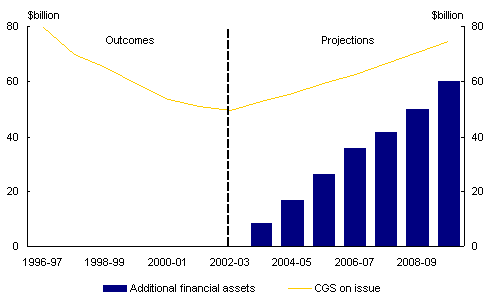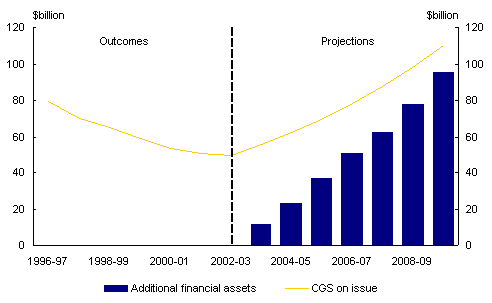If the Government decided to maintain the Commonwealth Government Securities (CGS) market, it would need to assess the level and composition of CGS outstanding necessary to ensure market viability. This also involves assessing the required growth rate of the CGS market over time. The required level of CGS issuance would inform development of any financial asset acquisition and management strategy.
The required level of CGS outstanding over time would depend on the rationale for maintaining the CGS market. Acceptance of different rationales is likely to lead to different conclusions about the market's necessary size and composition.
This paper identifies possible roles for the CGS market in the Australian financial market, and the economy more broadly. The volume of CGS outstanding necessary for the CGS market to meet these different roles may vary. However, the possible roles can be divided into two groups, with the required CGS outstanding likely to be broadly similar for each role within that group:
- first, as a pricing and referencing benchmark for other debt securities,
and managing financial risk; and - second, as a long-term investment vehicle and safe haven.
Commonwealth Government Securities as a benchmark for pricing other debt securities and managing financial risk
A range of maturities with a sufficient amount outstanding in each security to avoid liquidity risk is required for CGS to provide an accurate pricing benchmark. Some financial market participants have suggested that the Treasury bond yield curve should extend for around 10 years, with securities spread evenly across this period. They also suggest around $5 billion is required in each security to avoid liquidity risk. This implies the current volume of $50 billion outstanding can provide an adequate pricing benchmark.
The management of financial risk through Treasury bond futures contracts requires some volume of Treasury bonds outstanding. Presently, the Sydney Futures Exchange selects three or four benchmark securities to underpin each of the contracts. This suggests six to eight benchmarks of $5 billion (or a total of $30 billion to $40 billion) outstanding may be sufficient to fulfil this function.
Maintaining the CGS market at around current levels over time may not fulfil the roles of pricing and referencing other debt securities, and managing financial risks, as the potential size of transactions in the CGS and futures market also will increase as the economy grows. To minimise the risk of increasingly larger transactions having an undue impact on market prices, it has been suggested that the CGS and futures markets may need to grow by a rate similar to the economy's. In recent years, growth in nominal gross domestic product has averaged around 6 per cent per year.
[caption id="attachment_40155" align="aligncenter" width="492"] Chart 20: Commonwealth Government Securities outstanding if retired at maturity and no further issuance(a)[/caption]
Chart 20: Commonwealth Government Securities outstanding if retired at maturity and no further issuance(a)[/caption]
(a) Refers to Treasury bonds outstanding.
Source: Australian Office of Financial Management projections, 2002 (unpublished).
Net additional issuance of CGS would be required to maintain the CGS market at around $50 billion of outstandings and grow it at 6 per cent per year. On the basis of the current forward estimates and assuming budget balance in the period beyond 2005-06, CGS on issue could fall as low as $15 billion by 2009-10 if the Government allows CGS to mature and does not undertake new issuance (Chart 20). To offset this decline and grow the market by 6 per cent, the Commonwealth would need to accumulate a financial asset portfolio of around $60 billion by the end of the decade (Chart 21).
[caption id="attachment_40156" align="aligncenter" width="492"] Chart 21: Growing the Commonwealth Government Securities market in line with nominal growth in gross domestic product (a)[/caption]
Chart 21: Growing the Commonwealth Government Securities market in line with nominal growth in gross domestic product (a)[/caption]
(a) Refers to Treasury bonds outstanding.
Source: Australian Office of Financial Management and Treasury projections,
2002 (unpublished).
Commonwealth Government Securities as a long-term investment vehicle and safe haven
For the CGS market to act as a long-term investment vehicle and safe haven during financial instability, CGS on issue would need to be sufficient to meet the needs of investors over time. Investor demand for CGS is likely to increase during financial instability, when investors seek low-risk financial assets.
The life insurance and superannuation sectors are likely to have the highest demand for low-risk, long-dated, financial assets. Some financial market participants suggest that the current $50 billion of CGS on issue may be well below that required, given the rapid increase in funds under management. Assessing the appropriate size of the CGS market so it can play a safe haven role is difficult, but it is likely that it would require a greater volume of CGS. This reflects the strong growth in financial assets in Australia and the likelihood that the CGS market would need to at least maintain its share in the overall financial markets to be considered a safe haven (as financial market size will indicate the volume of assets that may seek a safe haven).
The size of the CGS market may need to increase over time to meet investor demand for low-risk, long-dated, financial assets. Assuming that investors such as superannuation funds and life insurance corporations aim to at least maintain the current share of CGS in their overall portfolio, CGS market growth may need to at least keep pace with the growth in financial assets. In recent years, financial assets in Australia have averaged around 12 per cent per year growth. This growth rate is also likely to be the minimum necessary to allow the CGS market to maintain a safe haven role.
Not all types of CGS can fulfil all the roles outlined in this paper. While, all CGS can play a role as safe haven assets during financial instability, only Treasury bonds and Treasury Indexed Bonds can act as long-term investment vehicles.
The Government would need net additional issuance of CGS to maintain the CGS market at around the current level of outstandings and grow it at 12 per cent per year (Chart 20). To address the expected decline in the CGS market and grow the market by 12 per cent, the Commonwealth would need to accumulate a financial asset portfolio of nearly $100 billion by the end of the decade (Chart 22).
[caption id="attachment_40158" align="aligncenter" width="492"] Chart 22: Growing the Commonwealth Government Securities market in line with growth in financial assets(a)[/caption]
Chart 22: Growing the Commonwealth Government Securities market in line with growth in financial assets(a)[/caption]
(a) Refers to Treasury bonds outstanding.
Source: Australian Office of Financial Management and Treasury projections,
2002 (unpublished).
Risk premium considerations
In assessing the ideal size of the CGS market, the Government needs to consider the impact of market size on interest rates. For relatively low levels of debt (compared with other developed countries), the impact on interest rates is likely to be modest. However, if the Government maintains a very large CGS market, then risk premiums on Australian interest rates may increase. The costs of these risk premiums would need to be compared with the benefits associated with maintaining the CGS market.
Key questions
The Government would appreciate views from stakeholders on the appropriate size of the CGS market in the event that the market is to be maintained.